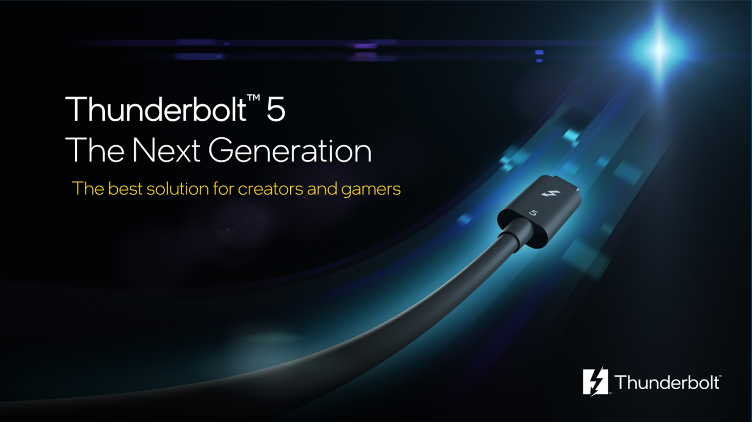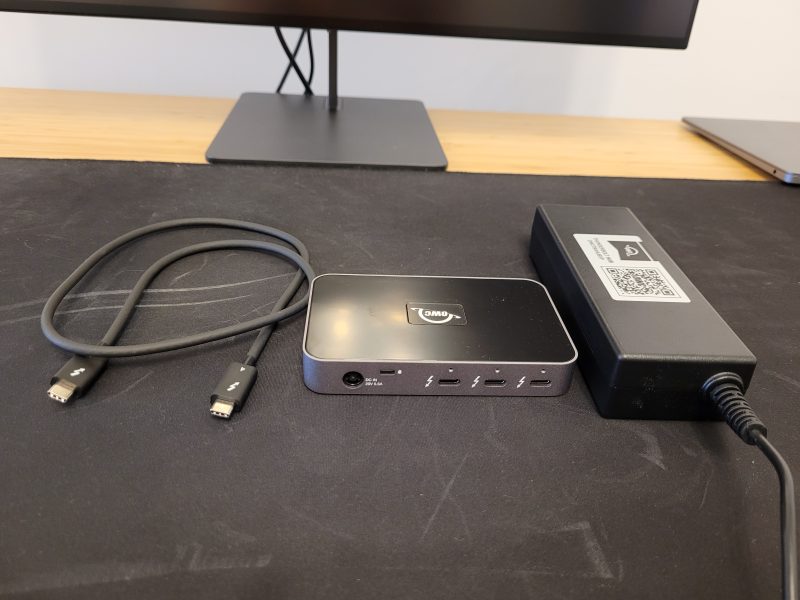There needs to be more clarity regarding Thunderbolt 4’s power delivery capabilities. It is frequently mixed with USB Power Delivery, an entirely different piece of technology. However, Thunderbolt is a USB specification (only in terms of the physical type-C port). With the similarities both the newer generations of USB (namely USB4) and Thunderbolt share, it gets hard to distinguish between them.
There are a lot of other subtle differentiators for these two. Still, for this article, we’re currently focusing on the power delivery standards of Thunderbolt and clearing up confusion associated with the maximum delivery it can handle.
Table of Contents
What is Thunderbolt 4?
Thunderbolt 4 is an advanced, high-performance port that is the latest evolution in connectivity technology.
It’s been specifically made to enhance data transfer, video, and power delivery capabilities, providing an efficient solution for contemporary computing and peripheral connectivity requirements.
The highlight feature of Thunderbolt 4 is a minimum bandwidth requirement of 32 Gbit/s for PCIe links, allowing accelerated data transmission, optimizing (and usually increasing) performance, and reducing completion times for a wide range of tasks.
One of its even better upgrades is the integration of Intel VT-d-based Direct Memory Access protection, which mitigates the risks of a physical DMA attack, safeguarding sensitive data and maintaining system integrity in case your device is ever compromised.
What is USB Power Delivery?
Initially, all USB ports could only give a basic charge of 5 volts with up to 500 milliamps. The newer ones can do 5 volts and 900 milliamps. But this is relatively slow, especially for devices that need more power. USB-C ports can be set to provide 5 volts with 1.5 amps or 3 amps. This gives you up to 15 watts of power, which is a bit faster but still not super quick compared to other charging methods. This is where USB PD comes into the picture.
USB Power Delivery, also known as USB PD, is like a supercharger for gadgets. It works with all sorts of devices that use USB ports to charge up. Imagine it as a special way of quickly filling up your device’s battery.
The most recent update, introduced in May 2021, is USB Power Delivery 3.1. This version takes charging to the next level. It divides the power into two ranges – one is called “standard power range,” and the other is “extended power range.” The standard power range is like the usual USB PD 3.0, but the extended power range is even more powerful. USB PD 3.1 can deliver 240 watts of power, making it the most powerful version yet. This improvement means faster charging and better performance for devices.
They’re Not the Same
They’re different technologies, albeit revolving around the same standard with a lot in common. There isn’t a direct comparison between the two, as USB Power Delivery is a power delivery standard universal to all USB specifications, while USB4 and Thunderbolt, in layperson’s terms, are essentially reversible connectors that can transmit data, video and audio signals, PCI-E signals, and power to devices, among others. Comparing the latest generation of Thunderbolt and USB 4 in terms of their power specifications helps clear the confusion between the two standards:
| Feature | Thunderbolt 4 | USB4 |
| Data Transfer Protocol | Thunderbolt protocol | USB4 protocol |
| Power Delivery | Up to 100W | Up to 100W |
| Minimum PC port power for accessories | 15W | 7.5W |
| Universal 40Gbps cables | Yes | No |
| Required Cable Type | Thunderbolt or USB-C | USB-C |
An important thing to note here is that USB 4 has a maximum power delivery rating
The latest version of PD, called USB Power Delivery Specification Revision 3.1 (a relatively mouthful name), was announced in 2021. This version is like a supercharger on steroids because it can give a massive 240 watts of power through the USB Type-C port. This means it can charge even big gadgets, like laptops, that need a lot of juice.
While Thunderbolt 4 currently is not up to par with what the limits of USB Power Delivery are, it is due to change pretty soon with the arrival of the newer Thunderbolt 5.
Newer Thunderbolt 5 Will Level the Field
Intel has officially announced Thunderbolt 5 on September 12, 2023, as the next generation of Thunderbolt. These include unprecedented speeds of up to 120Gbps, potential support for gaming monitors with a refresh rate of 540Hz, and an impressive charging power of 240 watts, among others. However, it is essential to note that while the Thunderbolt 5 specification has been officially released, PCs and accessories with Thunderbolt 5 support are expected to hit the market in 2024.

Thunderbolt 5 is built on the USB4 v2 platform, ensuring compatibility with previous versions of both Thunderbolt and USB. This is a significant upgrade from Thunderbolt 4, which supports speeds of up to 40Gbps. In contrast, Thunderbolt 5 can transmit data at a remarkable rate of 80Gbps and even up to 120Gbps when operating in Bandwidth Boost mode. This mode necessitates a high-bandwidth display; otherwise, Thunderbolt 5 will support bidirectional speeds of 80Gbps.
Jason Ziller, general manager of the client connectivity division at Intel, quotes that “Thunderbolt 5 will provide industry-leading performance and capability for connecting computers to monitors, docks, storage and more.
“Thunderbolt is now the mainstream port for connectivity on mobile PCs and delivering the next generation of performance with Thunderbolt 5 will provide even more capability for the most demanding users.”
Have a look at how generations of Thunderbolt have been delivering power and how Thunderbolt 5 leverages the limits of USB Power Delivery:
| Thunderbolt Version | Max. Voltage | Max. Current | Max. Power Delivery |
| Thunderbolt 1 | 18V | 550mA | 9.9W |
| Thunderbolt 2 | 18V | 550mA | 9.9W |
| Thunderbolt 3 | 18V | 550mA | Up to 100W |
| Thunderbolt 4 | 48V (with extended power range) | Up to 5A | At least 15W, up to 100W |
| Thunderbolt 5 | Unknown | Unknown | Up to 240W |
Closing Thoughts
Thunderbolt 4 only powers at a maximum of 100W, which puts it behind newer USB. Newer USB 4 devices currently are much more potent in terms of juicing capabilities. That will only be the case for a while, though, as Thunderbolt 5 is just around the corner. In 2024, newer docks, portable SSDs, and monitors will be rocking the newer standard. Since Thunderbolt is an objectively better technology, it would surpass USB4 to become the top-of-the-line connectivity technology. That leaves the question of what to choose between the two, but as it seems based on generational upgrades, the power delivery rating of both will level up sooner or later. So, if you’re concerned about charging speeds, you can rest assured about buying either of these two.






Nice article and very clear and informative for my level of understanding about this.
Thanks for sharing!
I have big issues mixing with THUNDERBOLT 3/4 and USB-C devices. On the back of my (Apple) LG UltraFine 24″ monitor there are 2 TB ports. Even if one of them is connected to the laptop TB port, the other still exhibits 20V DC. There is NO WARNING in any of Apple’s or LG’s documentation that you will destroy any 5V device if connected to that port. It is mechanically interchangeable with any USB-C connector. The 2 TB ports are adjacent to 3 USB 5V ports. There is no warning sticker saying DON’T CONNECT YOUR USB DEVICES HERE! (TB). As a result I have blown up a couple of external SSDs/Card readers hoping to find another black door to the laptop. I thought USB-PD was supposed to interrogate the connected equipment before establishing the voltage. This does not work on this monitor. There are other sources of lethal power also, coming from docks that provide charging power to laptops. Don’t hot swap these cables with 5V devices or you will be leaving silicon carcasses everywhere.
The industry needs to address these potential issues. Do Thunderbolt cables work like “e-chip” USB Cables? What happens if a plain USB cable attaches a 5V device to a 20V source without e-chip, especially when hot?
This is a field of land mines. The only way you have any idea what is happening is to obtain a USB power meter. How many people have those? Lessons learned: Don’t hot swap, check the voltage with a meter before attaching equipment.